
All Solutions
Page 308: Practice Questions
This function will be a straight line and so, $textbf{the domain and range }$will be real numbers, $D=R=Bbb{R}$.
$textbf{$x$-intercept:}$
$0=3x+2$
$3x=-2$
$x=-dfrac{2}{3}$
$textbf{$y$-intercept:}$
$y=3cdot0+2$
$y=2$
The slope of the equation is positive abd so the function will always be $textbf{increasing}$.This means that the function will be $textbf{negative }$ on $(-infty,-dfrac{2}{3})$ and $textbf{positive}$ on $(-dfrac{2}{3},infty)$.
On the following picture there is $textbf{a graph}$ of the function $y=dfrac{1}{3x+2}$:
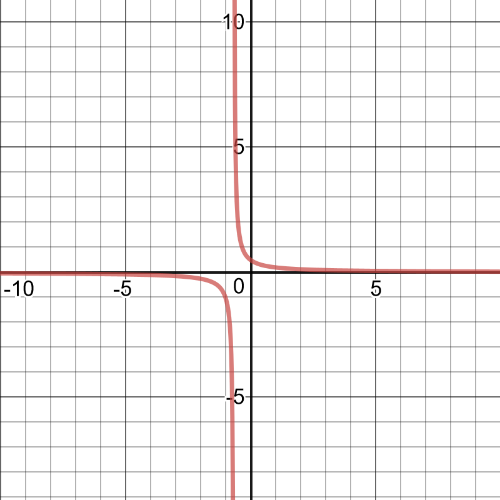
This function is quadriatic function and so $textbf{the domain}$ will be set $D=Bbb{R}$.The coefficient of the first term is positive and so the graph wil be pointed up.The function factors to $f(x)=(2x-1)(x+4)$, so, the $textbf{$x$-intercepts}$ are $x=0.5$ and $x=-4$.The graph will be $textbf{positive}$ on $(-infty,-4)$ and $(0.5,infty)$.The graph will be $textbf{negative}$ on $(-4,0.5)$.$textbf{The range}$ of the function will be set $R=left{yinBbb{R}|y>-10.125 right}$.The graph will be $textbf{decreasing}$ on $(-infty,-10.125)$ and $textbf{increasing}$ on $(-10.125,infty)$.On the following picture there is $textbf{a graph}$ of the function $y=dfrac{1}{2x^2+7x-4}$.
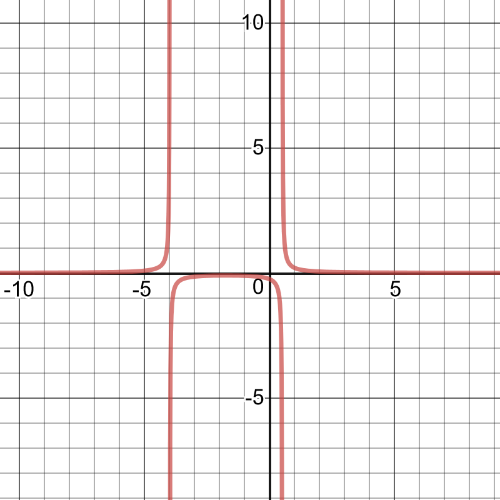
The function s quadriatic function, so, $textbf{the domain}$ will be set $D=Bbb{R}$.Because there are no real solutions to $0=2x^2+2$, the graph will have $textbf{no $x$-intercepts}$.The $textbf{$y$-intercept}$ is $y=2cdot0^2+2=2$.This means that $textbf{the range}$ is set $R=left{yinBbb{R}|y>2 right}$.This function is $textbf{increasing}$ on $(-infty,0)$ and $textbf{decreasing}$ on $(0,infty)$.Because the function has no $x$-intercepts and because the graph is facing up, the function will always be $textbf{positive}$.On the following picture there is a graph of a function $y=dfrac{1}{2x^2+2}$.
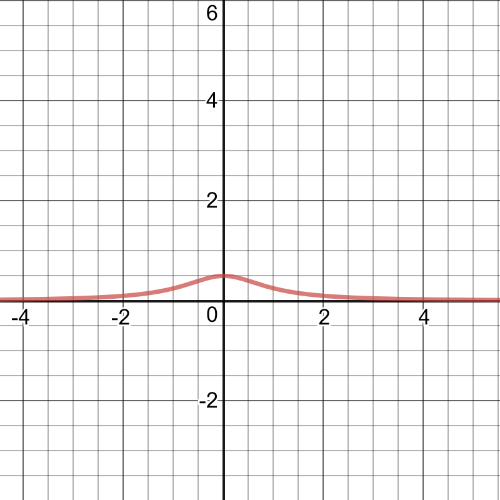
#### (a)
The function is linear. The domain and range are all real numbers. It is always decreasing.
The $x$-intercept is $x=2.5$. The $y$-intercept is $y=5$.
The function is positive on$(-infty, 2.5)$ and negative on $(2.5, infty)$.
The graph of the reciprocal function would be:
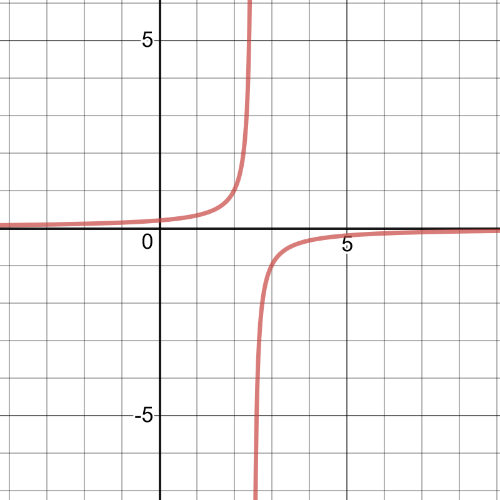
The function is a quadratic equation, which means that the domain of the function is $left{ x in Bbb{R} right}$.The $x$-intercepts of the function are $x=-3$ and $x=4$. The function is
$f(x)=(x+3)(x-4)=x^2-x-12$.The $y$-intercept of the function is $(0, -12).$The vertex can be found by finding the half-way point between the $x$-intercepts.
$dfrac{-3+4}{2}= 0.5$
$f(0.5)=((0.5)+3)((0.5)-4)= (3.5)(-3.5)= -12.25$
The vertex is $(0.5, -12.25)$. This means that the range of the function is $left{y in Bbb{R}|y > -12.25 right}$.The function is decreasing on $(-infty, -12.25)$ and increasing on $(-12.25, infty)$. Use this information to graph the reciprocinal of the function.
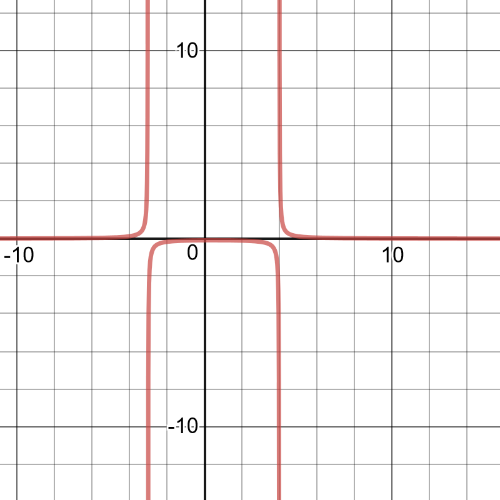
To find $textbf{the vertical asymptote}$ find the zeros of the expression in the denominator:
$0=x+17 Rightarrow x=-17$
Because the numerator of the rational function is a constant, $textbf{the horizontal asymptote}$ would be $y=0$.
#### (b)
To find $textbf{the vertical asymptote}$ find the zeros of the expression in the denominator:
$0=5x+3 Rightarrow 5x=-3 Rightarrow x=-dfrac{3}{5}$
Divide the leading coefficient of the numerator and denominator to find the equation of $textbf{horizontal asymptote}$:
$y=dfrac{2x}{5x}=dfrac{2}{5}$
#### (c)
To find $textbf{the vertical asymptote}$ find the zeros of the expression in the denominator:
$0=-4x^2-42x+22 Rightarrow 0=(x+11)(x-0.5)$
So, we can conclude that euqtions of vertical asymptotes are $x=-11$ and $x=0.5$.
Notice that $(x+11)$ is a factor in both the denominator and the numerator, this means that there is $textbf{a hole}$ at $x=-11$.Because the degree of the expression in the denominator is $2$ and the degree of the expression in the numerator is $1$, $textbf{the horizontal asymptote}$ will bw $y=0$.
To find $textbf{the vertical asymptote}$ find the zeros of the expression in the denominator:
$0=x-1 Rightarrow x=1$
So, the equation of vertical asymptote is $x=-1$.
Because the degree of the expression in the denominator is $2$ and the degree of the expression in the denominator is $1$, there will be an $textbf{oblique asymptote}$.Divide the numerator by the denominator, the non-remainder part is the equation of the oblique asymptote:
$y=3x+3$.
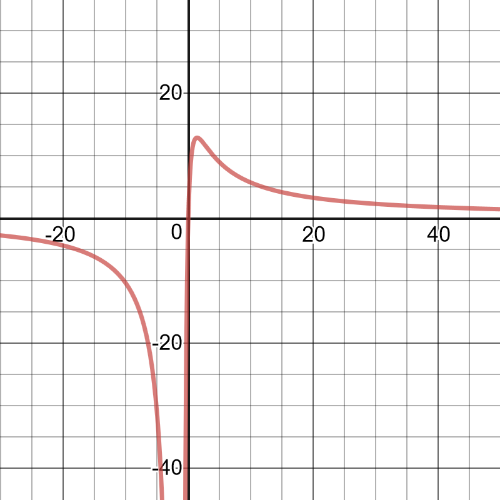
$textbf{This function does not intercept $x$-axis}$.This means that the $textbf{horizontal asymptote}$ is $y=0$.
$y$-intercept: $f(0)=dfrac{2}{0+5}=dfrac{2}{5}$
The function has $textbf{a vertical asymptote}$ at $x=-5$.This means $textbf{that domain}$ of the function is set $D=left{xinBbb{R}|xne-5 right}$.The function will be $textbf{negative}$ for $x-5$.On the following picture there is $textbf{a graph}$ of this function.This function is $textbf{decreasing}$ on its domain.
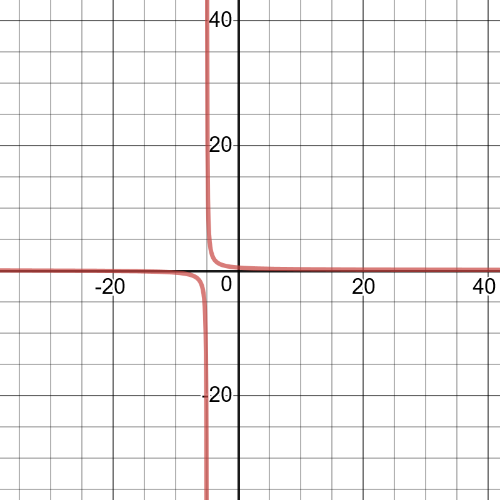
Notice that the function factors to $f(x)=dfrac{4(x-2)}{x-2}=4$.
This means that there will be $textbf{a hole}$ at $x=2$ and the garph opf the function will be the horizontal line $y=4$.The function is $textbf{positive}$ everywhere except $x=2$.$textbf{There is no $x$-intercept}$ and $y$-intercept is $y=4$.The function is $textbf{constant}$.On the following picture there is $textbf{a graph}$ of this function.
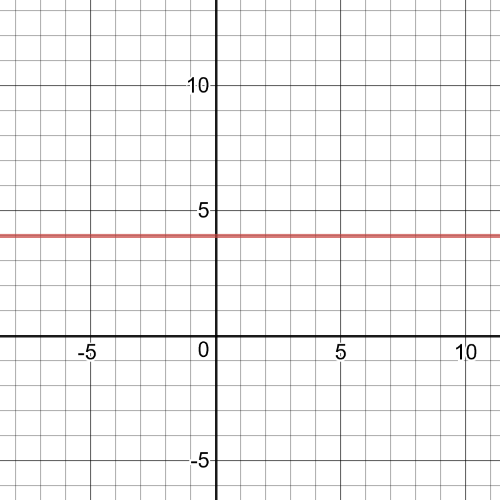
Notice that the function factors to $f(x)=dfrac{x-6}{3(x-6)}=dfrac{1}{3}$.
This means that there will be $textbf{a hole}$ at $x=6$ and the garph of the function will be the horizontal line $y=dfrac{1}{3}$.The function is $textbf{positive}$ everywhere except $x=6$.$textbf{There is no $x$-intercept}$ and $y$-intercept is $y=dfrac{1}{3}$.The function is $textbf{constant}$.On the following picture there is $textbf{a graph}$ of this function.
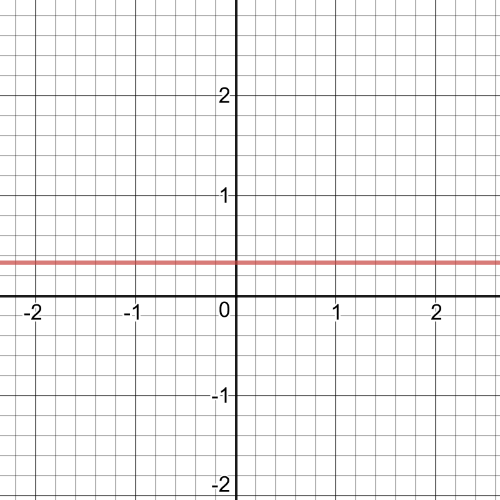
To find $textbf{vertical asymptote}$ of this function, we need to find zero of the expression in the denominator.
$0=2x+1 Rightarrow 2x=-1 Rightarrow x=-dfrac{1}{2}=-0.5$
The function will have a $textbf{vertical asymptote}$ at $x=-0.5$.This means that $textbf{the domain}$ is set $D=left{xinBbb{R}|x-0.5 right}$.
$x$-intercept: $dfrac{4x}{2x+1}=0 Rightarrow 4x=0 Rightarrow x=0$
$y$-intercept: $dfrac{4cdot0}{2cdot0+1}=0$
Divide the first terms of the expressions in the numerator and the denominator to find the equation of the $textbf{horizontal asymptote}$:
$y=dfrac{4x}{2x}=2$
Use the following table to determine when the function is positive and negative. We can see that function is $textbf{positive}$ on $x0$ and $textbf{negative}$ on $-0.5<{x}<0$.

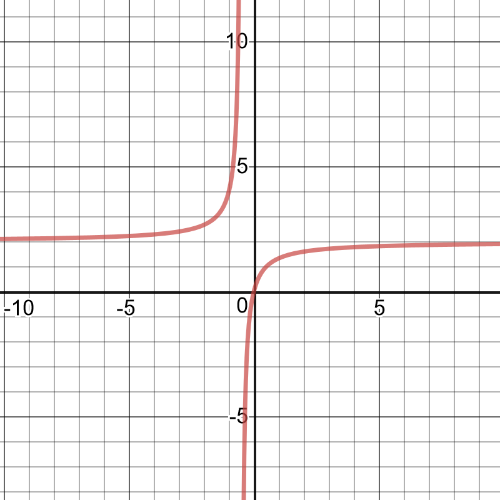
$f(5.99)=dfrac{1}{(5.99)-6}=-100$
$f(6.01)=dfrac{1}{(6.01)-6}=100$
To the left of the vertical asymptote the function moves towards $-infty$.To the right of the asymptote the function moves towards $infty$.
$dfrac{x-6}{x+2}=0 Leftrightarrow x-6=0 Leftrightarrow x=6$
On the following picture there is $textbf{a graph}$ from which we can see solution:
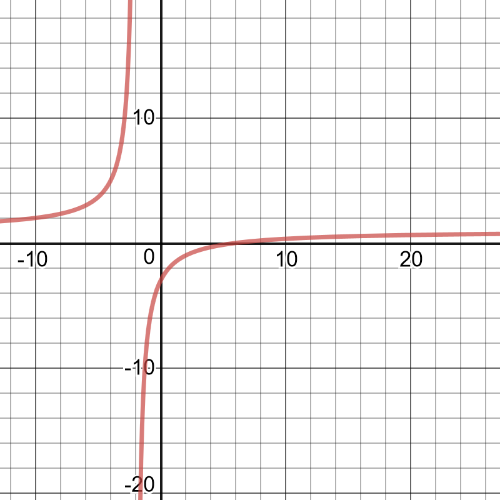
$15x+7=dfrac{2}{x} /cdot{x}$
$x(15x+7)=2$
$15x^2+7x-2=0$
The roots of this function are $x=0.2$ and $x=-dfrac{2}{3}$, which we can see from the following $textbf{graph}$.
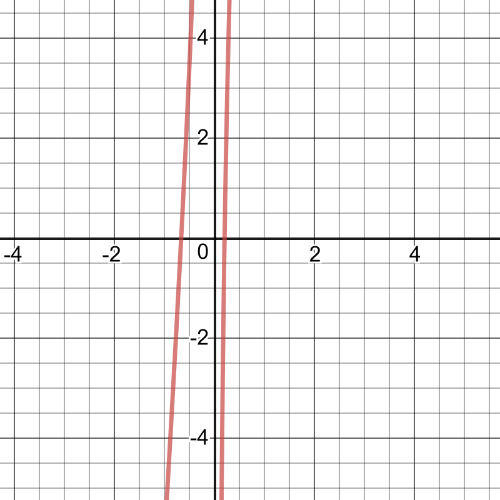
$dfrac{2x}{x-12}=dfrac{-2}{x+3} /(x-12)(x+3)$
$2x(x+3)=-2(x-12)$
$2x^2+6x=-2x+24$
$2x^2+8x-24=0$
$2(x+6)(x-2)=0$
We can conclude that $textbf{solutions}$ are $x=-6$ or $x=2$, which we can see from the following $textbf{graph}$.
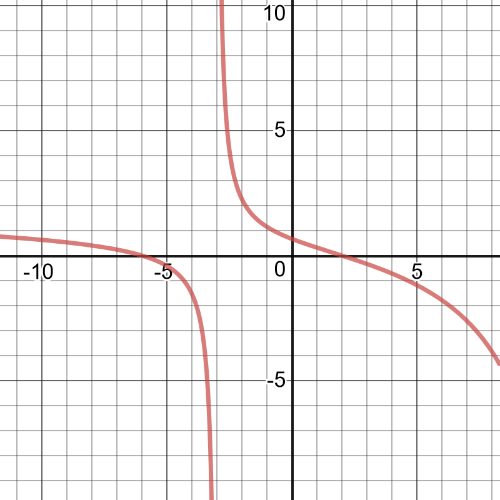
$dfrac{x+3}{-4x}=dfrac{x-1}{-4} /(-4x)$
$x+3=x(x-1)$
$x+3=x^2-x$
$x^2-2x-3=0$
$(x+1)(x-3)=0$
We can conclude that $textbf{solutions}$ are $x=-1$ or $x=3$, which we can see from the following $textbf{graph}$.
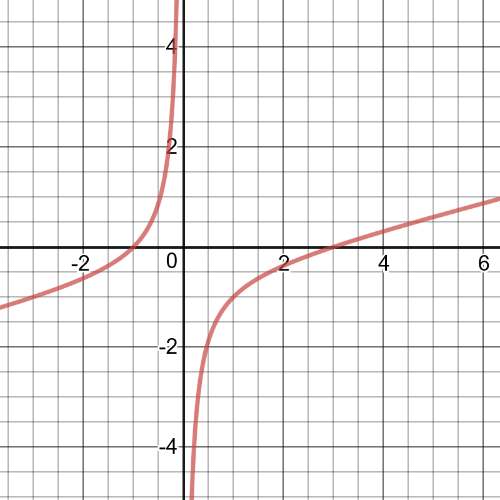
$dfrac{2}{m}+dfrac{1}{m-5}=dfrac{1}{3.23}$
$3.23m(m-5)(dfrac{2}{m}+dfrac{1}{m-5}=dfrac{1}{3.23})$
$3.23(m-5)(2)+3.23m=m(m-5)$
$6.46m-32.3+3.23m=m^2-5m$
$0=m^2-14.69m+32.3$
Use the quadratic formula to determine the roots of this quadratic equation.
$m=12$ and $2.69$
The possible answers are $12$ minutes and $2.69$ minutes. But because Janet’s time has to be grater than $5$ minutes, $textbf{the answer must be $12$ minutes.}$ It takes Janet about $12$ minutes to wash the car.
$c(x)=dfrac{50x}{x^2+3x+6}$.
To determine when the contrecation is $6.16 g/L$ solve the equation
$6.16=dfrac{50x}{x^2+3x+6}$
.
$6.16=dfrac{50x}{x^2+3x+6}$
$6.16(x^2+3x+6)=dfrac{50x}{x^2+3x+6}(x^2+3x+6)$
$6.16x^2+18.48x+36.96=50x$
$6.16x^2-31.52x+36.96=0$
Use the quadratic formula to solve this equation. $x=3.297$ and $1.82$
$$
textbf{The contrecation of the chemical will be $6.16 g/L$ at $1.82$ and $3.297$ days.}
$$
$-x+5<dfrac{1}{x+3}$
$-x+5-dfrac{1}{x+3}<0$
$(dfrac{x+3}{x+3})(-x)+(dfrac{x+3}{x+3})5-dfrac{1}{x+3}<0$
$dfrac{-x^2-3x}{x+3}+dfrac{5x+15}{x+3}-dfrac{1}{x+3}<0$
$dfrac{-x^2+2x+14}{x+3}<0$
$dfrac{(x+2.873)(x-4.873)}{x+3}<0$
$textbf{The inequality is true on $x<-3$ and $-2.873 < x < 4.873$.}$
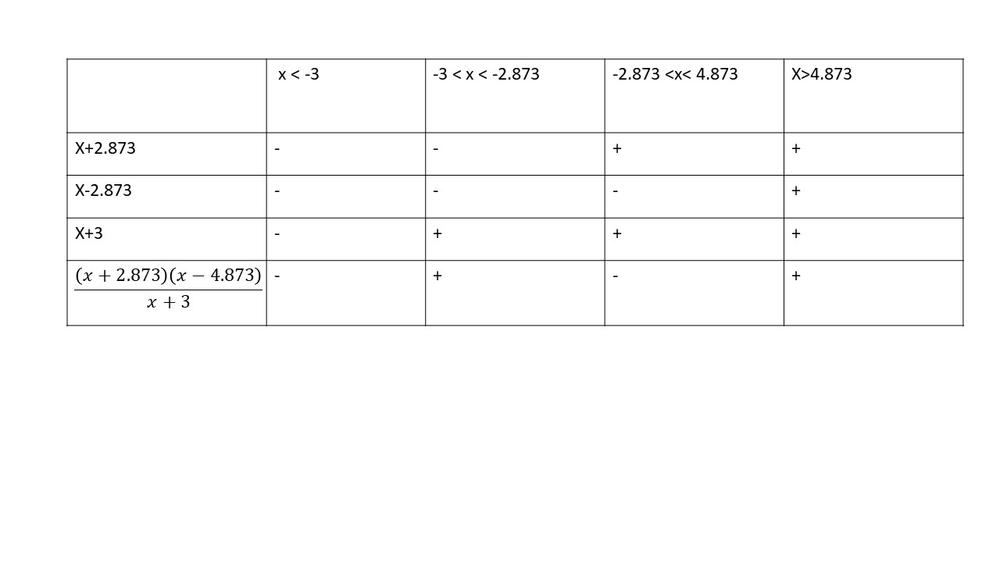
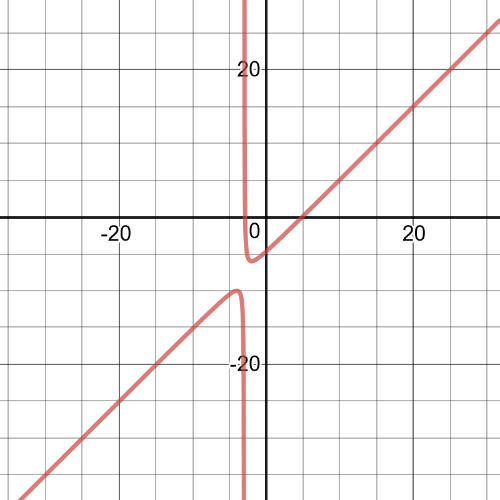
$dfrac{55}{x+16} >-x$
$dfrac{55}{x+16}+x>0$
$dfrac{55}{x+16}+(dfrac{x+16}{x+16})x>0$
$dfrac{x^2+16x+55}{x+16}>0$
$dfrac{(x+5)(x+11)}{x+16}>0$
$textbf{This ineqiality is true on $-16<{x}-5$}$.
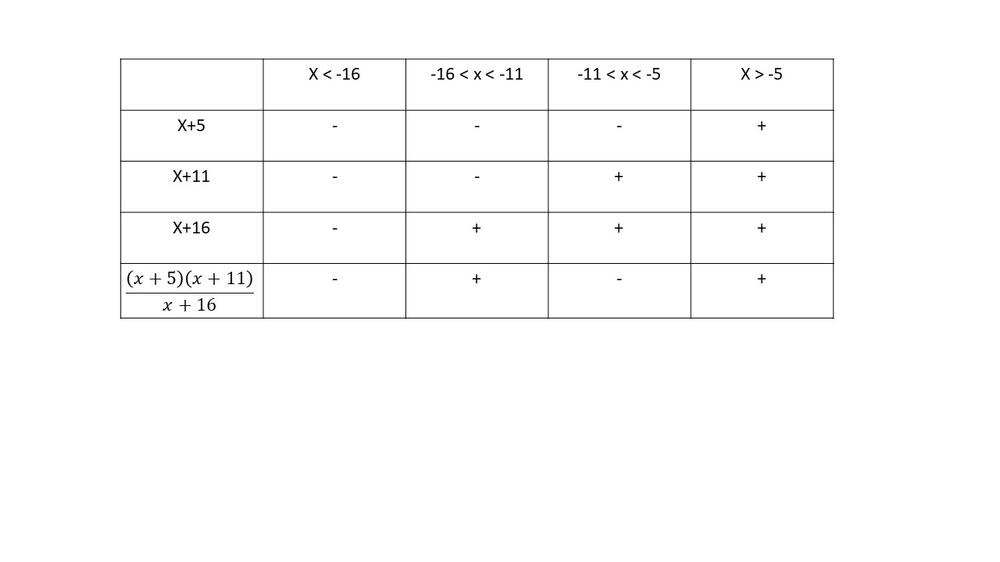
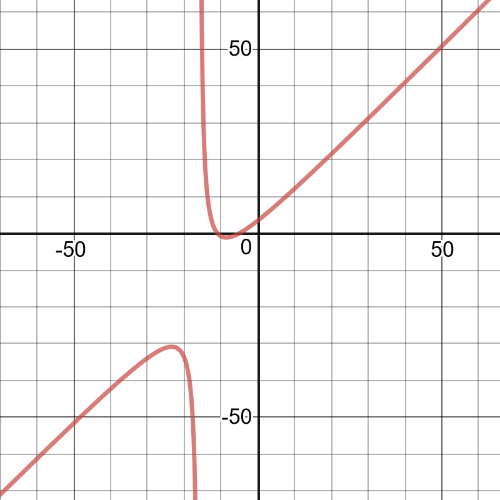
$dfrac{2}{3x+4}>dfrac{x}{x+1}$
$dfrac{2x}{3x+4}-dfrac{x}{x+1}>0$
$(dfrac{x+1}{x+1})dfrac{2x}{3x+4}-dfrac{x}{x+1}dfrac{3x+4}{3x+4}>0$
$dfrac{2x^2+2x}{(x+1)(3x+4)}-dfrac{3x^2+4x}{(x+1)(3x+4)}>0$
$dfrac{-x^2-2x}{(x+1)(3x+4)}>0$
$dfrac{-x(x+2)}{(x+1)(3x+4)}>0$
$textbf{The inequality is true on}$ $-2 < x < -1.33$ and $-1 < x <0$.
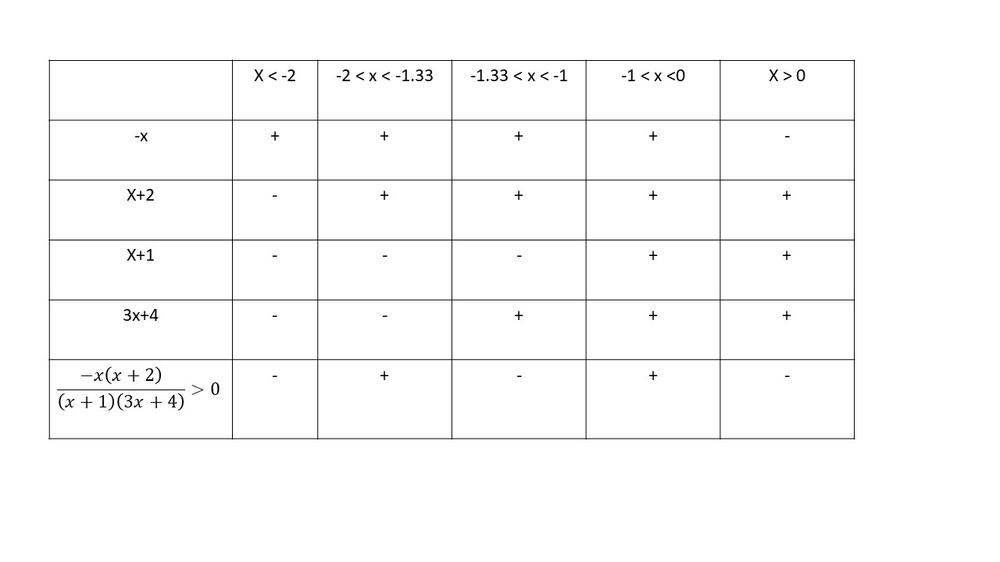
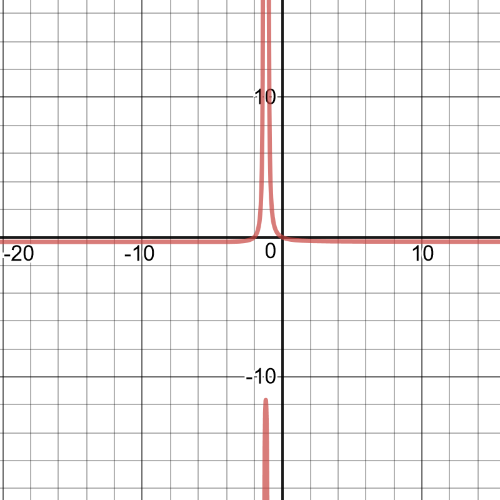
$dfrac{x}{6x-9}leq dfrac{1}{x}$
$dfrac{x}{6x-9}-dfrac{1}{x}leq 0$
$(dfrac{x}{x})dfrac{x}{6x-9}-dfrac{1}{x}(dfrac{6x-9}{6x-9})leq 0$
$dfrac{x^2}{(x)(6x-9)}+dfrac{-6x+9}{(x)(6x-9)}leq 0$
$dfrac{x^2-6x+9}{(x)(6x-9)}leq 0$
$dfrac{(x-3)(x-3)}{(x)(6x-9)}leq 0$
$$
textbf{The inequality is true on $0 < x < 1.5$.}
$$
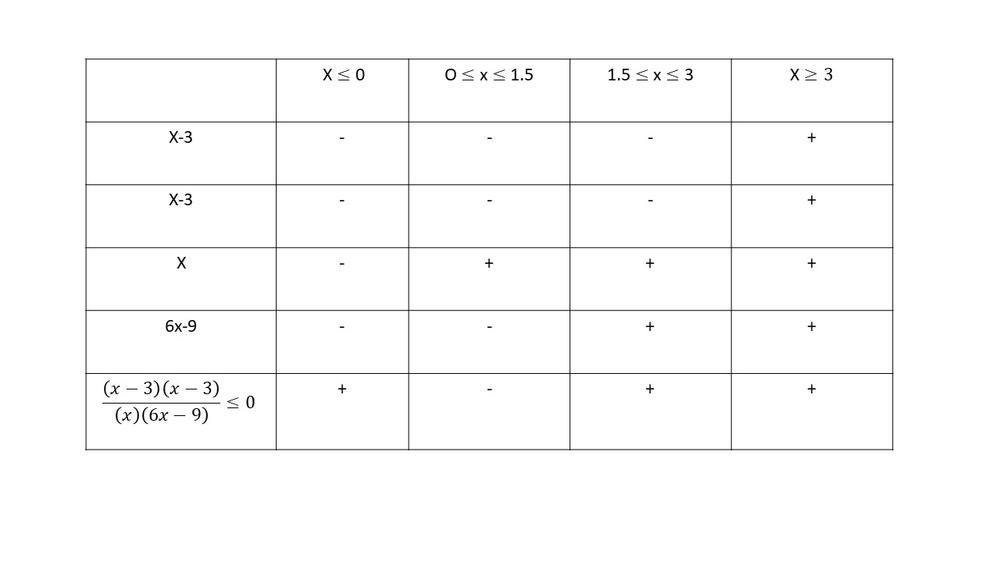
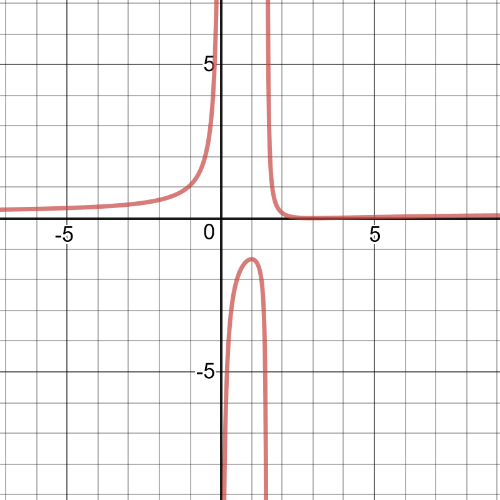
(b)$-16<{x}-5$
(c) $-2 < x < -1.33$ and $-1 < x <0$
(d) $0 < x < 1.5$
$f(t)=dfrac{40t}{t^2+1}$. The actual population is modelled by
$g(t)=dfrac{45t}{t^2+8t+7}$. Graph $dfrac{45t}{t^2+8t+7}$ and $dfrac{40t}{t^2+1}$ to determine where $g(t)>f(t)$.
$$
textbf{$g(t)$ appears to be greater than $f(t)$ on $-6.7<x<-1.01$ and $-0.73<x<0$.}
$$
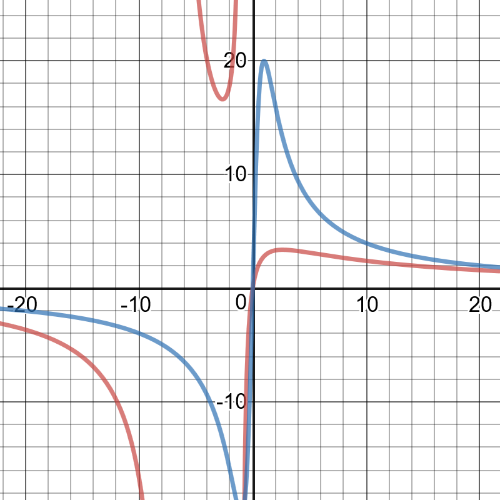
$dfrac{x+3}{x-3}, x=4$
$f(4)= dfrac{4+3}{4-3}=7$
$f(4.01)=dfrac{4.01+3}{4.01-3}=6.94$
$textbf{Difference Quotient}$=$dfrac{6.94-7}{0.01}=dfrac{-0.06}{0.01}=-6$
$$
textbf{The vertical asymptote occurs at $x=3$}
$$
#### (b)
$f(x)=dfrac{2x-1}{x^2+3x+2}, x=1$
$f(1)=dfrac{2(1)-1}{(1)^2+3(1)+2}=0.167$
$f(1.01)=dfrac{2(1.01)-1}{(1.01)^2+3(1.01)+2}=0.169$
$textbf{Difference Quotient}$=$dfrac{0.169-0.167}{0.01}=dfrac{0.002}{0.01}=0.2$
$$
textbf{The vertical asymptotes occur at $x=-2$ and $x=-1$.}
$$
(b) $x=-2$ and $x=-1$
To find the average rate of change during the first two hours of the drug’s ingestion, find $c(2)$ and $c(0)$
$c(2)=dfrac{5(2)}{(2)^2+7}=dfrac{10}{11}=0.91$
$c(0)=dfrac{5(0)}{(0)^2+7}=0$
Average Rate of Change:
$dfrac{0.91-0}{2-0}=0.455 mg/L/h$
#### (b)
Use the difference quotient to help you determine the drug’s instantaneous rate of change at $t=3$.
$c(3)=dfrac{5(3)}{(3)^2+7}=0.9375$
$c(3.01)=dfrac{5(3.01)}{(3.01)^2+7}=dfrac{15.05}{16.0601}=0.9371$
Difference Quotient = $dfrac{0.9371-0.9375}{0.01}=dfrac{-0.004}{0.01}=-0.04 mg/L/h$
#### (c)
Graph the function $c(t)=dfrac{5t}{t^2+7}$.
$textbf{The concetration of the drug in the blood stream appears to be increasing most rapidly during the first hour and a half: the graph is steep and increasing during this time}$.
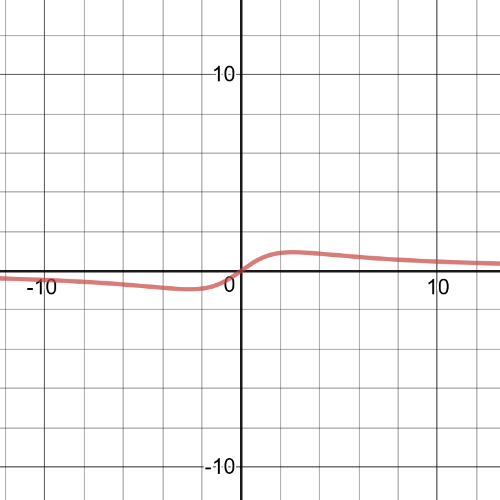
(b) $-0.04 mg/L/h$
(c) see solution
$-2x+20=dfrac{2x}{x-4}$
$(-2x+20)(x-4)=2x$
$-2x^2+8x+20x-80=2x$
$-2x^2+26x-80=0$
$x^2-13x+40=0$
$(x-5)(x-8)=0$
The two points of intersection would be $x=5$ and $x=8$. The point with the line parallel to the secant line would lie half-way in between these two points, $x=6.5$.
$x=6.5$
As the $x$-coordinate approaches the vertical asymptote of a rational function, the line tangent to the graph will get closer and closer to being a vertical line. This means that the slope of the line tangent to the graph will get larger and larger, approaching positive or negative infinity depending on the function, as $x$ get closer to the vertical asymptote.
#### (b)
As the $x$-coordinate grows larger and larger in either direction, the line tangent to the graph will get closer and closer to being a horizontal line. This means that the slope of the line tangent to the graph will always approach zero as $x$ gets larger and larger.

